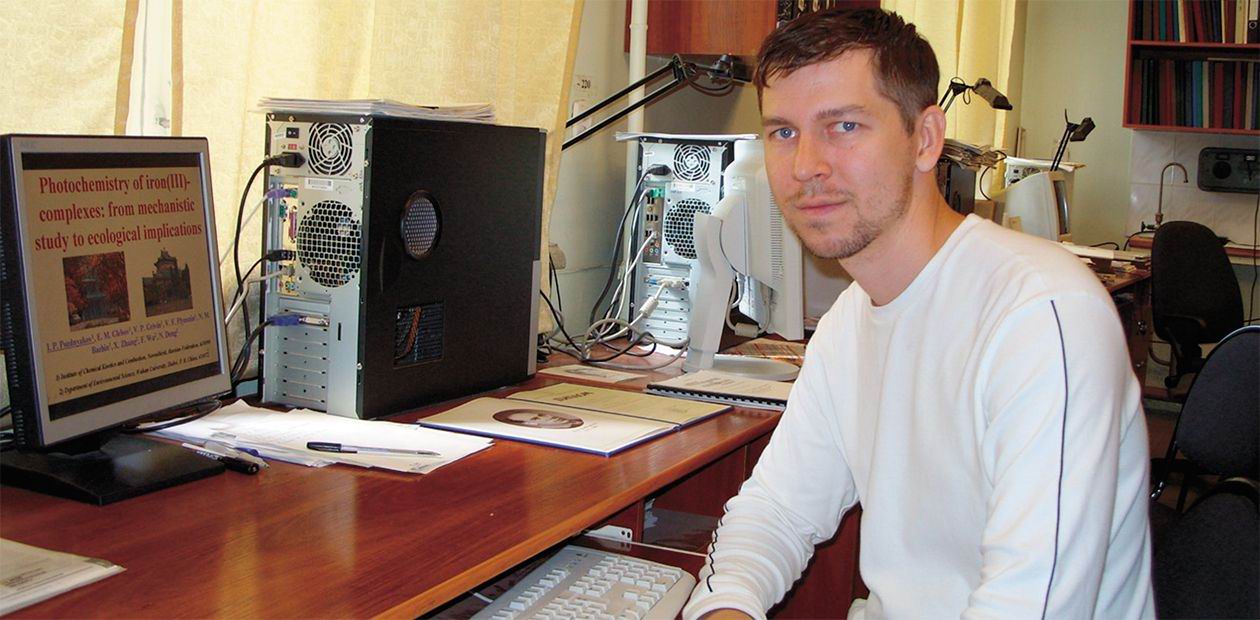Purifying Light
In 2008 the V. V. Voyevodsky prize for young scientists was awarded to the researcher of the Institute of Chemical Kinetics and Combustion (ICKC) of the Siberian Branch of the Russian Academy of Sciences (SB RAS), Candidate of Chemistry Ivan Pozdnyakov. His work is devoted to the photochemistry of iron complexes and free organic acids in aqueous solutions. The new results obtained at the ICKC assist in understanding the mechanisms of self-purification taking place in natural water systems and are promising for development of photocatalysts for sewage purification based on iron complexes.
Ivan Pozdnyakov entered the Ecology Section of the Natural Sciences Department at Novosibirsk State University in 1995. His first truely scientific study was carried out after his first year at the University during summer practice in a research station at Krotovaya Lyaga Lake. During the third year at the University, Ivan participated in an expedition to the Vasyugan marsh in the Tomsk region, where interesting results on the effect of the vegetable cover on methane emission were obtained. These field studies coupled with profound academic education brought him to serious research in ecological photochemistry.
Ecological photochemistry studies various processes in the environment initiated by sunlight. The best known photochemical phenomenon is photosynthesis. This is the process leading to the formation of organic matter from carbon dioxide and water that accounts for life on our planet. The reverse process, photodegradation, is less known but is equally important. It leads to mineralization of organic substances.
During the last two decades there has been stable interest in the world to photodegradation of organic substances taking place in natural waters under solar light irradiation. This interest is related to the growing anthropogenic pressure on the environment, need for expanding our knowledge on natural photoprocesses, and search of new catalysts for sewage purification. Both natural and model ecological systems are being actively investigated.
Iron is widely spread on the Earth, and photochemical reactions with participation of this element largely determine transformations of organic substances. The complexes of iron (III) with organic acids and hydroxyl ions were found to be among the most important photoactive compounds in natural water systems. The effect of the solar irradiation on water containing such compounds leads to reduction of Fe(III) to Fe(II) accompanied by photodegradation and mineralization of the dissolved organic substances. Meanwhile, the mechanisms of natural photochemical reactions have not been sufficiently studied yet. In particular, the nature of short-living species formed after absorption of solar energy by compounds dissolved in water is practically unknown.
The studies by Pozdnyakov and his co-authors are characterized by the application of time-resolved methods to the problems of ecological photochemistry. In contrast to the steady-state methods yielding information only about the initial and final states of the studied system, time-resolved methods make it possible to study the processes in dynamics. This modern approach has allowed the researchers to obtain information on the nature of primary short-living species formed during photodegradation and study reaction mechanisms in detail.
The main experimental method used by the Novosibirsk photochemists is nanosecond laser flash photolysis. It is based on the following effect: a strong laser pulse whose duration is several nanoseconds and which imitates solar radiation creates a high concentration of short-living species (these may be excited states of molecules or radicals) in the sample. As a result, the optical properties of the sample and the intensity of the probing light passing through it are changed. A reconfigurable monochromator and a registration system consisting of a photoelectron multiplier, an analog-digital converter and a computer make it possible to measure the sample absorption at different wavelengths, thus obtaining optical spectra and measuring the lifetime of short-living species in microsecond timescale.
The laser flash photolysis method has many times showed its efficiency for investigation of ecologically important iron complexes. For instance, several years ago Pozdnyakov and his co-authors found that a highly reactive hydroxyl radical was formed during photoexcitation of Fe(III) complexes. The reaction of this radical with a number of typical pollutants was found to result in their photooxidation and eventual mineralization to harmless substances – carbon dioxide and water. By the way, this study was also awarded the V. V. Voyevodsky prize in 2002.
Another area of studies interesting from the ecological viewpoint is photochemistry of aromatic acids and their complexes with the same Fe(III) ions. One of such acids – salicylic – is widely known as a component of cosmetic agents. Derivatives of salicylic acid (SAD) are the simplest analogs of complex humic acids dissolved in natural water and can be used as a convenient model object. Ivan Pozdnyakov has managed to show that, although iron complexes with SAD are stable, Fe(III) photoreduction takes place due to the electron transfer from the aromatic anion excited with light provided that free SAD ions are present in the solution. The obtained data have made it possible to postulate one of the possible natural mechanisms accounting for active photodegradation of organic substances – photoreduction of iron complexes due to intermolecular electron transfer from the excited states of aromatic acids.
The investigation of the iron complexes with simpler organic acids, such as tartaric, lactic and oxalic acids showed that in this case the primary photochemical process corresponded to an intramolecular electron transfer from the organic anion to the Fe(III) ion with the formation of a long-living radical complex. Before that another mechanism based entirely on steady-state measurements was described in the literature. Now it is clear that this mechanism is incorrect.
The new results substantially advance our knowledge of photochemical transformations in the nature and are interesting for a wide range of scientists working in the areas of ecological and fundamental photochemistry. These data can be potentially used for evaluation of the contribution of photochemical reactions with participation of iron complexes and organic acids to the global balances of carbon, sulfur and nitrogen and for the search of highly efficient photocatalysts for sewage purification.
These studies carried out at the Institute of Chemical Kinetics and Combustion SB RAS will be logically continued by going from the model systems to much more complex natural macromolecules – humic acids and their complexes with Fe(III) ions.





